PEUGEOT EXPERT 2018 Owners Manual
Manufacturer: PEUGEOT, Model Year: 2018, Model line: EXPERT, Model: PEUGEOT EXPERT 2018Pages: 416, PDF Size: 14.12 MB
Page 101 of 416
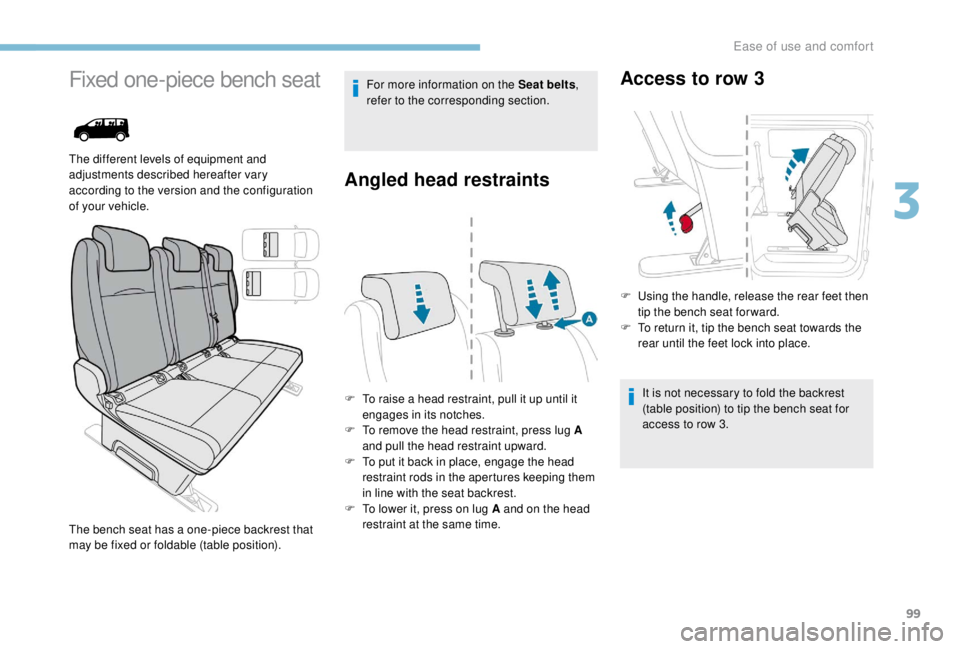
99
Fixed one-piece bench seat
The different levels of equipment and
adjustments described hereafter vary
according to the version and the configuration
of your vehicle.For more information on the Seat belts
,
refer to the corresponding section.
Angled head restraints
F To raise a head restraint, pull it up until it engages in its notches.
F
T
o remove the head restraint, press lug A
and pull the head restraint upward.
F
T
o put it back in place, engage the head
restraint rods in the apertures keeping them
in line with the seat backrest.
F
T
o lower it, press on lug A and on the head
restraint at the same time.
The bench seat has a one-piece backrest that
may be fixed or foldable (table position).
Access to row 3
F Using the handle, release the rear feet then
tip the bench seat for ward.
F
T
o return it, tip the bench seat towards the
rear until the feet lock into place.
It is not necessary to fold the backrest
(table position) to tip the bench seat for
access to row 3.
3
Ease of use and comfort
Page 102 of 416
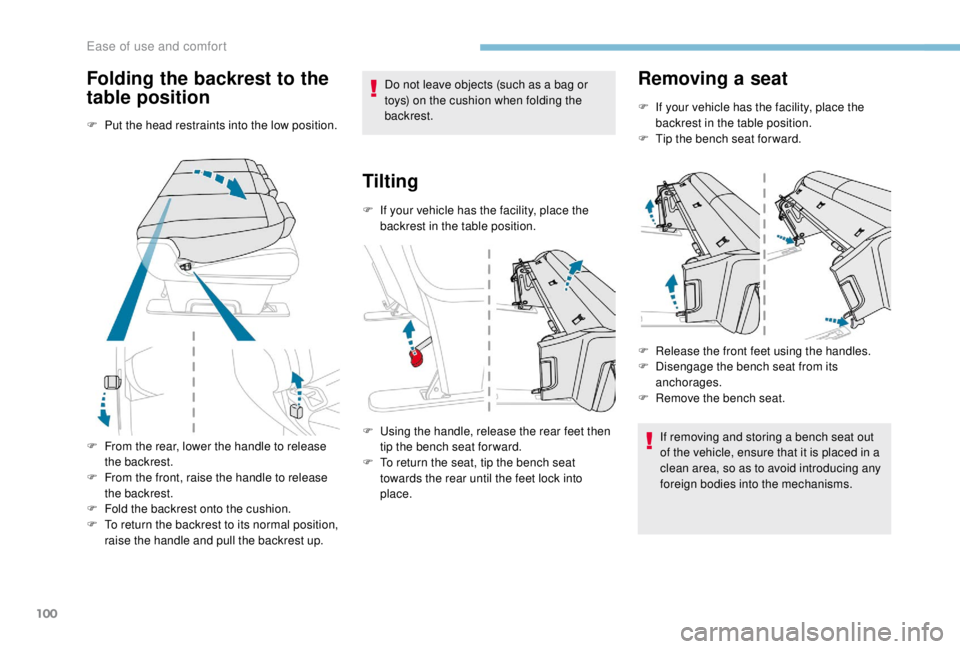
100
Folding the backrest to the
table position
F Put the head restraints into the low position.
F
F
rom the rear, lower the handle to release
the backrest.
F
F
rom the front, raise the handle to release
the backrest.
F
F
old the backrest onto the cushion.
F
T
o return the backrest to its normal position,
raise the handle and pull the backrest up. Do not leave objects (such as a bag or
toys) on the cushion when folding the
backrest.
Tilting
F If your vehicle has the facility, place the
backrest in the table position.
F
U
sing the handle, release the rear feet then
tip the bench seat for ward.
F
T
o return the seat, tip the bench seat
towards the rear until the feet lock into
place. F
R
elease the front feet using the handles.
F
D
isengage the bench seat from its
anchorages.
F
R
emove the bench seat.
If removing and storing a bench seat out
of the vehicle, ensure that it is placed in a
clean area, so as to avoid introducing any
foreign bodies into the mechanisms.
Removing a seat
F If your vehicle has the facility, place the backrest in the table position.
F
T
ip the bench seat for ward.
Ease of use and comfort
Page 103 of 416
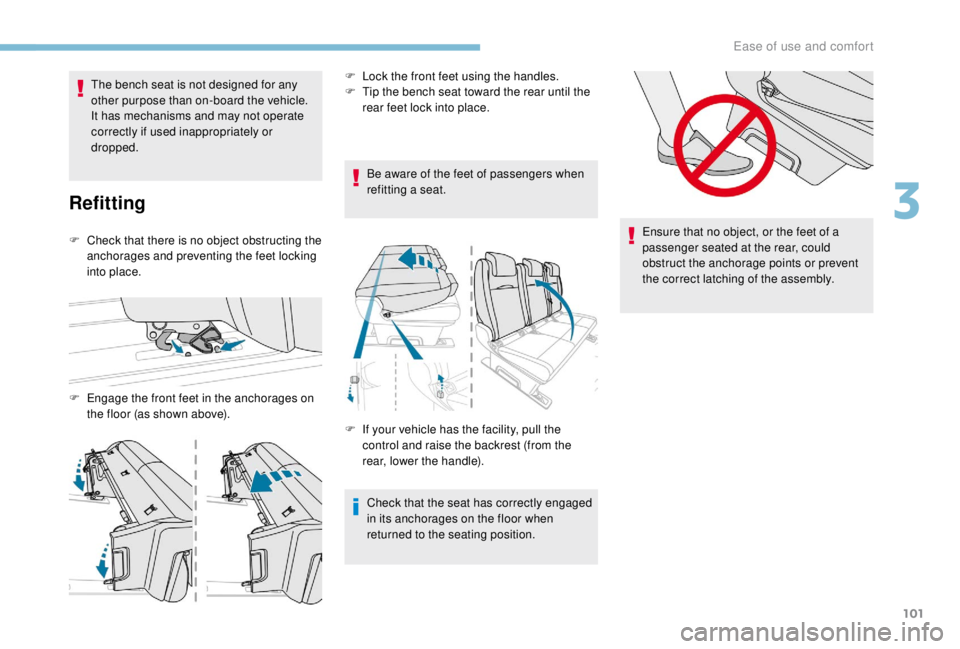
101
The bench seat is not designed for any
other purpose than on-board the vehicle.
It has mechanisms and may not operate
correctly if used inappropriately or
dropped.
Refitting
F Check that there is no object obstructing the anchorages and preventing the feet locking
into place.
F
E
ngage the front feet in the anchorages on
the floor (as shown above). F
L
ock the front feet using the handles.
F
T
ip the bench seat toward the rear until the
rear feet lock into place.
Be aware of the feet of passengers when
refitting a seat.
F
I
f your vehicle has the facility, pull the
control and raise the backrest (from the
rear, lower the handle).
Check that the seat has correctly engaged
in its anchorages on the floor when
returned to the seating position. Ensure that no object, or the feet of a
passenger seated at the rear, could
obstruct the anchorage points or prevent
the correct latching of the assembly.
3
Ease of use and comfort
Page 104 of 416
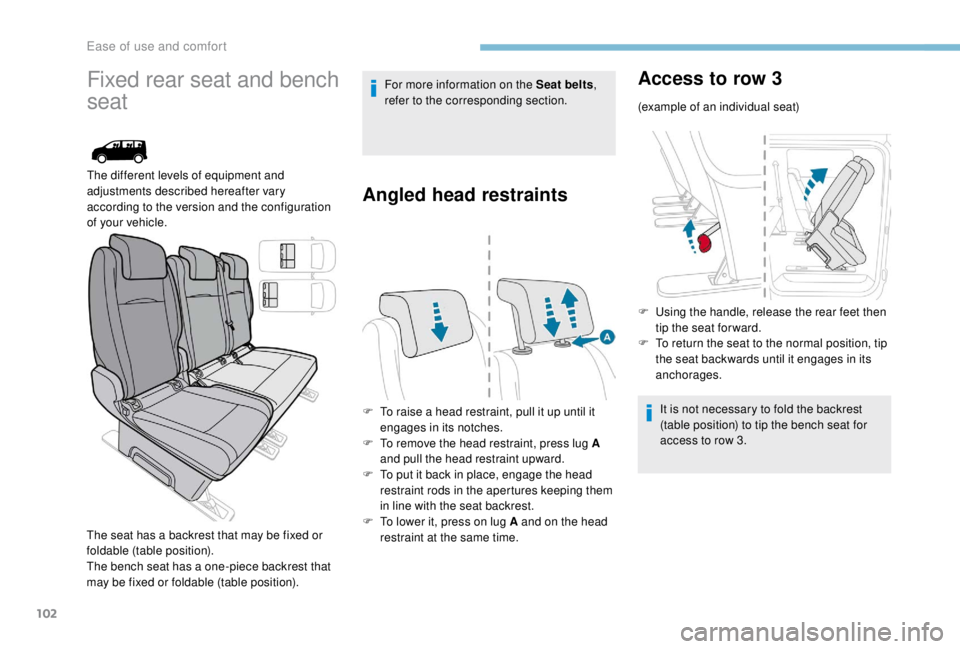
102
Fixed rear seat and bench
seat
The different levels of equipment and
adjustments described hereafter vary
according to the version and the configuration
of your vehicle.
The seat has a backrest that may be fixed or
foldable (table position).
The bench seat has a one-piece backrest that
may be fixed or foldable (table position). For more information on the Seat belts
,
refer to the corresponding section.
Angled head restraints
F To raise a head restraint, pull it up until it engages in its notches.
F
T
o remove the head restraint, press lug A
and pull the head restraint upward.
F
T
o put it back in place, engage the head
restraint rods in the apertures keeping them
in line with the seat backrest.
F
T
o lower it, press on lug A and on the head
restraint at the same time.
Access to row 3
(example of an individual seat)
F
U
sing the handle, release the rear feet then
tip the seat for ward.
F
T
o return the seat to the normal position, tip
the seat backwards until it engages in its
anchorages.
It is not necessary to fold the backrest
(table position) to tip the bench seat for
access to row 3.
Ease of use and comfort
Page 105 of 416
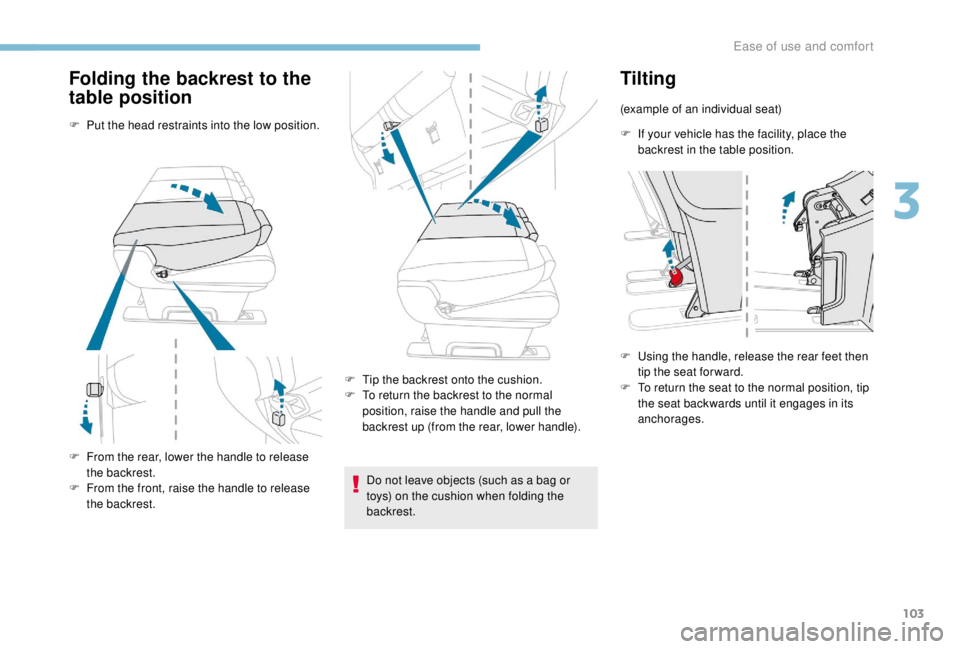
103
Folding the backrest to the
table position
F Put the head restraints into the low position.
F
F
rom the rear, lower the handle to release
the backrest.
F
F
rom the front, raise the handle to release
the backrest. F
T
ip the backrest onto the cushion.
F
T
o return the backrest to the normal
position, raise the handle and pull the
backrest up (from the rear, lower handle).
Do not leave objects (such as a bag or
toys) on the cushion when folding the
backrest.
Tilting
(example of an individual seat)
F
I
f your vehicle has the facility, place the
backrest in the table position.
F
U
sing the handle, release the rear feet then
tip the seat for ward.
F
T
o return the seat to the normal position, tip
the seat backwards until it engages in its
anchorages.
3
Ease of use and comfort
Page 106 of 416
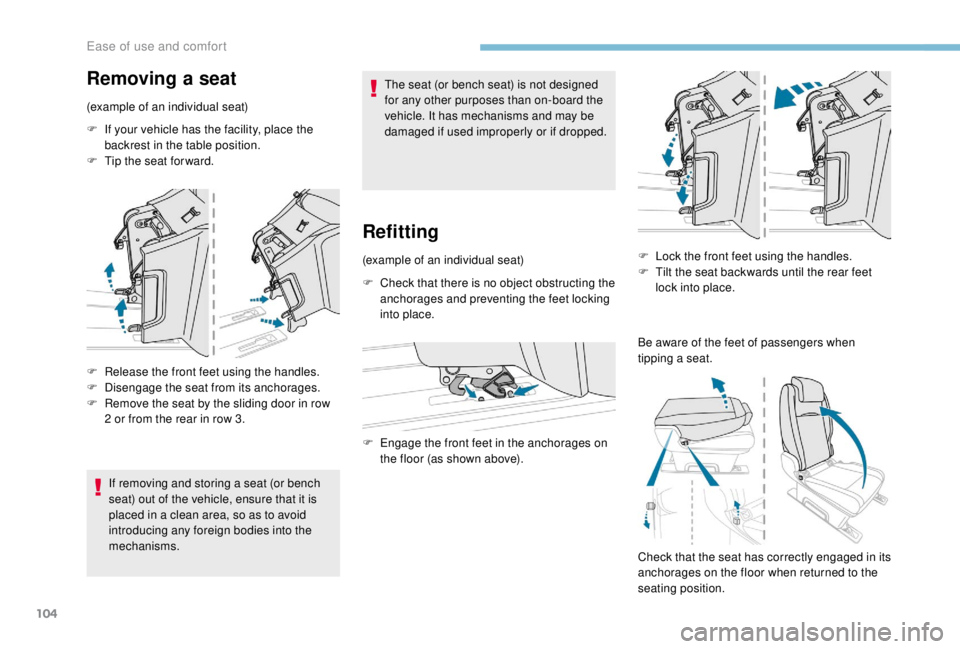
104
Removing a seat
(example of an individual seat)
F
I
f your vehicle has the facility, place the
backrest in the table position.
F
T
ip the seat for ward.
F
R
elease the front feet using the handles.
F
D
isengage the seat from its anchorages.
F
R
emove the seat by the sliding door in row
2
or from the rear in row 3.
If removing and storing a seat (or bench
seat) out of the vehicle, ensure that it is
placed in a clean area, so as to avoid
introducing any foreign bodies into the
mechanisms. The seat (or bench seat) is not designed
for any other purposes than on-board the
vehicle. It has mechanisms and may be
damaged if used improperly or if dropped.
Refitting
(example of an individual seat)
F
C
heck that there is no object obstructing the
anchorages and preventing the feet locking
into place.
F
E
ngage the front feet in the anchorages on
the floor (as shown above).
Check that the seat has correctly engaged in its
anchorages on the floor when returned to the
seating position.
F
L ock the front feet using the handles.
F T ilt the seat backwards until the rear feet
lock into place.
Be aware of the feet of passengers when
tipping a seat.
Ease of use and comfort
Page 107 of 416
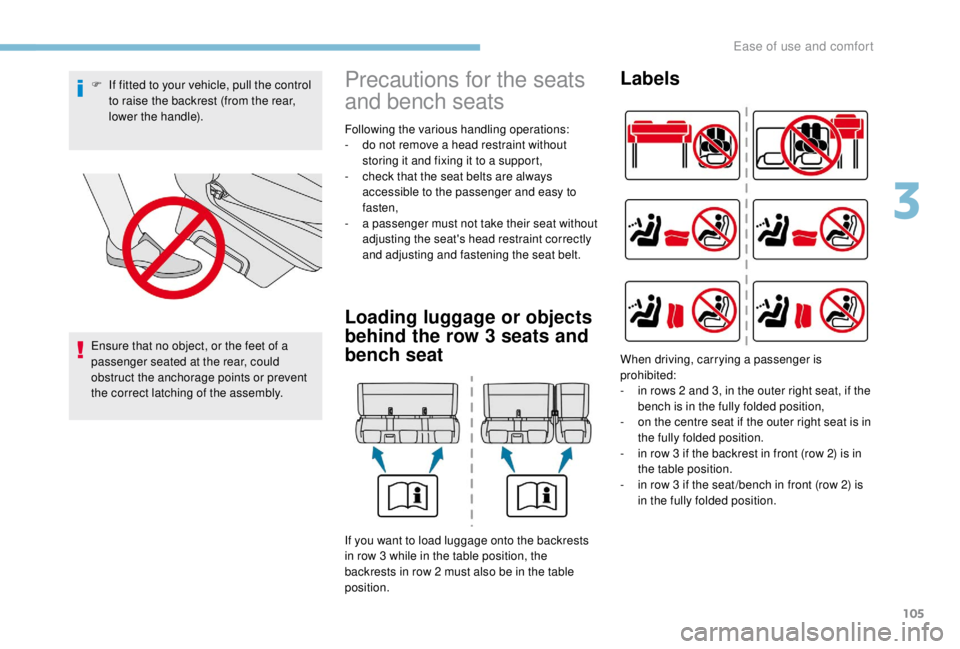
105
F If fitted to your vehicle, pull the control to raise the backrest (from the rear,
lower the handle).
Ensure that no object, or the feet of a
passenger seated at the rear, could
obstruct the anchorage points or prevent
the correct latching of the assembly.Precautions for the seats
and bench seats
Following the various handling operations:
- d o not remove a head restraint without
storing it and fixing it to a support,
-
c
heck that the seat belts are always
accessible to the passenger and easy to
fasten,
-
a p
assenger must not take their seat without
adjusting the seat's head restraint correctly
and adjusting and fastening the seat belt.
Loading luggage or objects
behind the row 3 seats and
bench seat
If you want to load luggage onto the backrests
in row 3
while in the table position, the
backrests in row 2
must also be in the table
position.
Labels
When driving, carrying a passenger is
prohibited:
-
i
n rows 2 and 3, in the outer right seat, if the
bench is in the fully folded position,
-
o
n the centre seat if the outer right seat is in
the fully folded position.
-
i
n row 3 if the backrest in front (row 2) is in
the table position.
-
i
n row 3 if the seat /bench in front (row 2) is
in the fully folded position.
3
Ease of use and comfort
Page 108 of 416
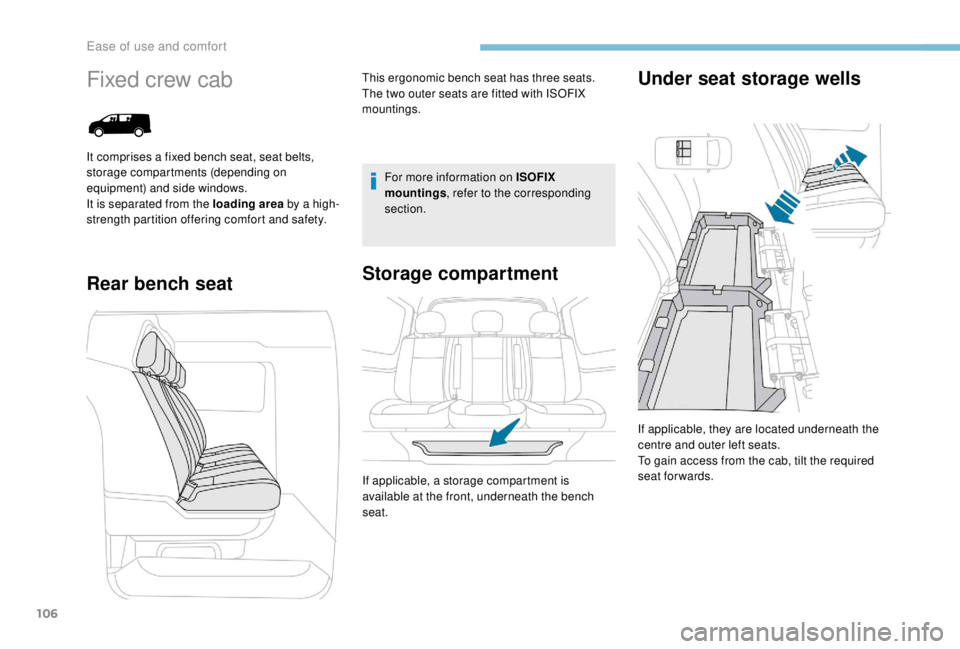
106
Fixed crew cab
Rear bench seatStorage compartment Under seat storage wells
For more information on ISOFIX
mountings
, refer to the corresponding
section.
If applicable, they are located underneath the
centre and outer left seats.
To gain access from the cab, tilt the required
seat forwards.
This ergonomic bench seat has three seats.
The two outer seats are fitted with ISOFIX
mountings.
If applicable, a storage compartment is
available at the front, underneath the bench
seat.
It comprises a fixed bench seat, seat belts,
storage compartments (depending on
equipment) and side windows.
It is separated from the loading area
by a high-
strength partition offering comfort and safety.
Ease of use and comfort
Page 109 of 416
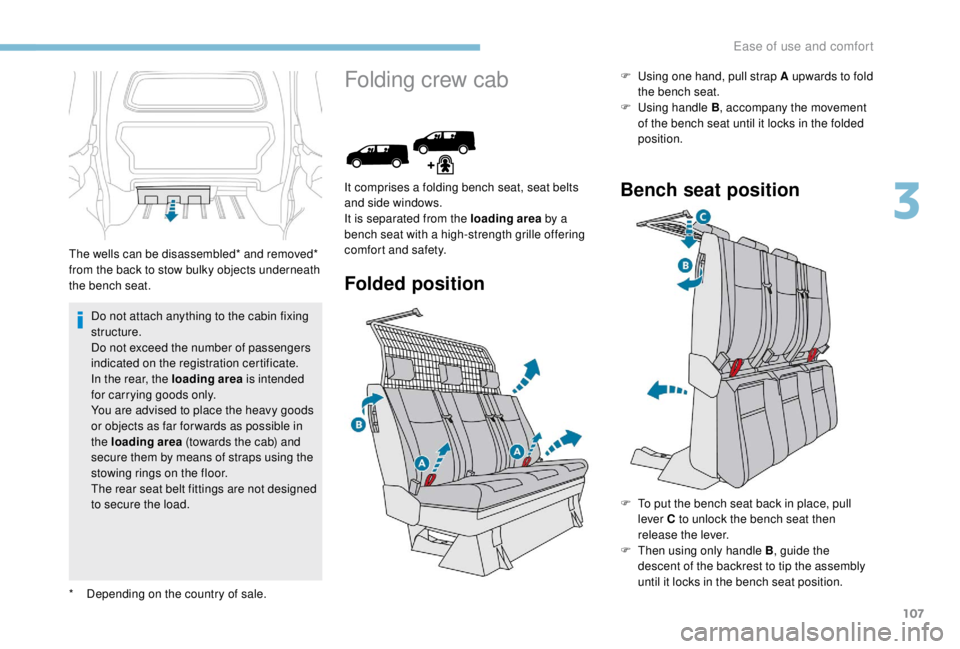
107
Do not attach anything to the cabin fixing
structure.
Do not exceed the number of passengers
indicated on the registration certificate.
In the rear, the loading area is intended
for carrying goods only.
You are advised to place the heavy goods
or objects as far for wards as possible in
the loading area (towards the cab) and
secure them by means of straps using the
stowing rings on the floor.
The rear seat belt fittings are not designed
to secure the load.
The wells can be disassembled* and removed*
from the back to stow bulky objects underneath
the bench seat.
*
D
epending on the country of sale.
Folding crew cab
Folded position
It comprises a folding bench seat, seat belts
and side windows.
It is separated from the loading area by a
bench seat with a high-strength grille offering
comfort and safety. F
Us
ing one hand, pull strap A upwards to fold
the bench seat.
F
Us
ing handle B
, accompany the movement
of the bench seat until it locks in the folded
position.Bench seat position
F To put the bench seat back in place, pull lever C to unlock the bench seat then
release the lever.
F
T
hen using only handle B , guide the
descent of the backrest to tip the assembly
until it locks in the bench seat position.
3
Ease of use and comfort
Page 110 of 416
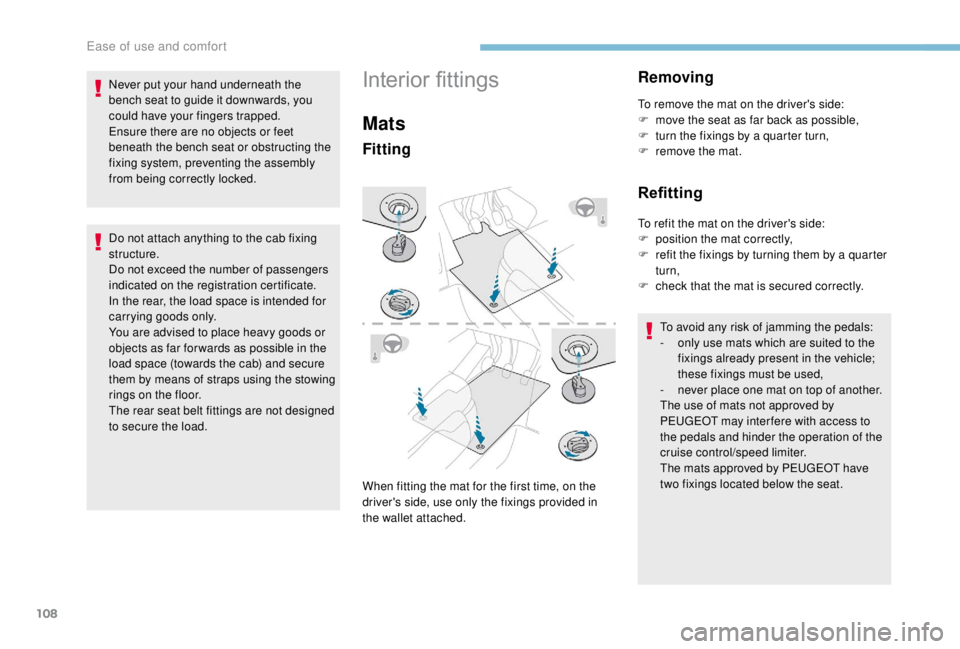
108
Do not attach anything to the cab fixing
structure.
Do not exceed the number of passengers
indicated on the registration certificate.
In the rear, the load space is intended for
carrying goods only.
You are advised to place heavy goods or
objects as far for wards as possible in the
load space (towards the cab) and secure
them by means of straps using the stowing
rings on the floor.
The rear seat belt fittings are not designed
to secure the load.
Interior fittings
Mats
Fitting
When fitting the mat for the first time, on the
driver's side, use only the fixings provided in
the wallet attached.
Removing
To remove the mat on the driver's side:
F m ove the seat as far back as possible,
F
t
urn the fixings by a quarter turn,
F
r
emove the mat.
Refitting
To refit the mat on the driver's side:
F p osition the mat correctly,
F
r
efit the fixings by turning them by a quarter
turn,
F
c
heck that the mat is secured correctly.
To avoid any risk of jamming the pedals:
-
o
nly use mats which are suited to the
fixings already present in the vehicle;
these fixings must be used,
-
n
ever place one mat on top of another.
The use of mats not approved by
PEUGEOT may inter fere with access to
the pedals and hinder the operation of the
cruise control/speed limiter.
The mats approved by PEUGEOT have
two fixings located below the seat.
Never put your hand underneath the
bench seat to guide it downwards, you
could have your fingers trapped.
Ensure there are no objects or feet
beneath the bench seat or obstructing the
fixing system, preventing the assembly
from being correctly locked.
Ease of use and comfort